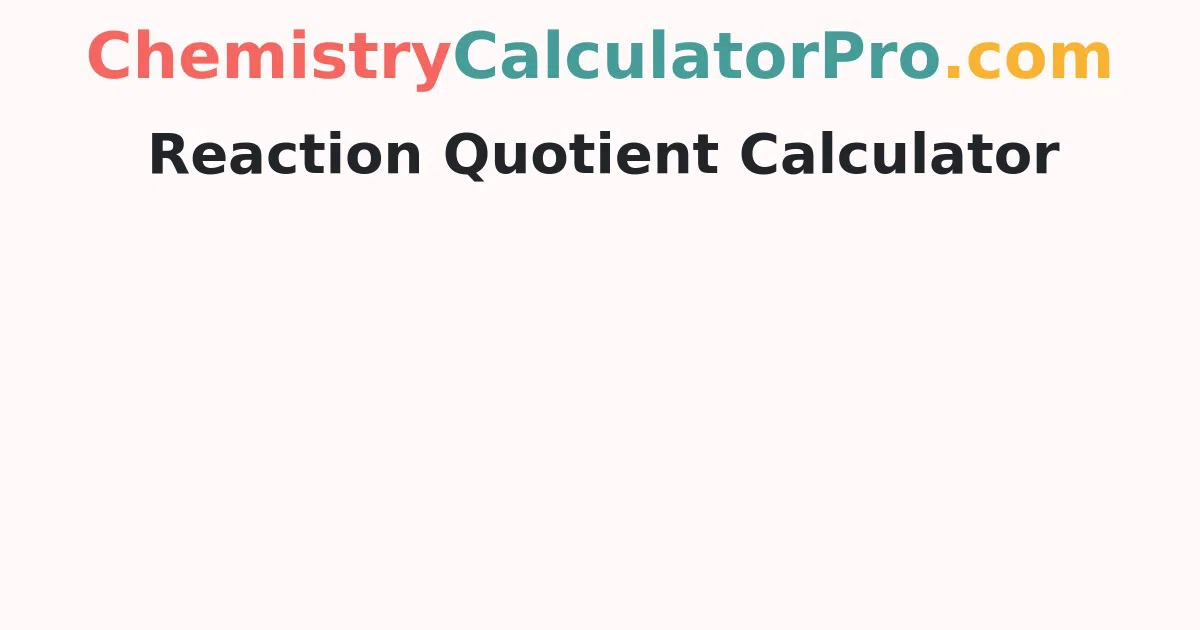Reaction Quotient Calculator
Utilise the free Reaction Quotient Calculator to estimate in which direction your reaction is moving. You just have to enter the concentration and number of moles of all reactants and products in the specified input fields. Press the calculate button to check the reaction quotient as output with an explanation.
What is the Reaction Quotient?
The reaction quotient is a function of pressures or concentrations of the reactants, and products involved in the chemical reaction at a particular time. It is useful to find the direction of the chemical reaction.
Reaction quotient Q is constant in a special case (at the equilibrium state of the reaction) and is equal to the equilibrium constant K.
Reaction Quotient Formula
The reaction quotient can be calculated only for reversible reactions.
The general chemical equation is
aA + bB ⇌ cC + dD
Where,
- lower case letters (a, b, c, d) are stoichiometric coefficients
- upper case letter (A, B, C, D) are the activities of the substances.
The reaction quotient equation is given as:
Q = [C]c [D]d / [A]a [B]b
The state of reaction when the equilibrium is not attained is given as:
If Q < K, the reaction will move from reactants to products.
aA + bB → cC + dD
If Q > K, the reaction will move from products to reactants.
cC + dD → aA+bB
How to Find Reaction Quotient from Q Equation?
The detailed step by step process to calculate the reaction quotient from a chemical reaction is along the lines:
- Choose your chemical reaction.
- Find at what temperature and pressure, the reaction reaches equilibrium state.
- Get the concentration of the products, reactants either before or after the equilibrium.
- Balance the chemical equation and make a note the chemical species coefficients.
- Substitute the values in the reaction quotient formula.
- The result is the reaction quotient for the chemical reaction.
Example:
Find the reaction quotient for Cd + Cl ⇌ Cdcl4. The concentrations of Cd is 1 M, Cl is 0.5 M, CdCl4 is 0.25 M, the equilibrium constant K = 108 at 25oC, find the direction of the reaction.
Solution:
Given reaction is Cd + Cl ⇌ Cdcl4
Balanced reaction is Cd2+ + Cl- ⇌ Cdcl42-
The concentrations are: [Cd2+] = 1 M
[Cl-] = 0.5 M
[CdCl42-] = 0.25 M
Reaction quotient is Q = [CdCl4] / [Cd2+] [Cl-]4 = .25 / (1 x 0.54) = 4
Q < K, so the reaction is unbalanced towards the reactants.
FAQ's on Reaction Quotient Q Calculator
1. What is the reaction quotient?
Reaction Quotient Q is defined as the ratio of the product of initial concentrations of products in the reaction to the product of initial concentrations of the reactants under non-equilibrium conditions.
2. Can the reaction quotient be zero?
Yes, the reaction quotient can become zero when we are left with only reactants in the equation.
3. What is the difference between K and Q in equilibrium?
The equilibrium constant is K while the reaction quotient is Q. K is used for finding the ratio of the amounts of products to the reactants when the reaction is at an equilibrium state. While Q is used to find whether the chemical reaction is at equilibrium or not.
4. Does the reaction quotient change with time?
In the equilibrium state, the reaction quotient is constant and is equal to the equilibrium constant.
